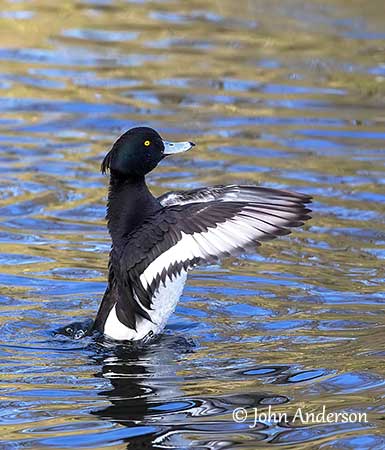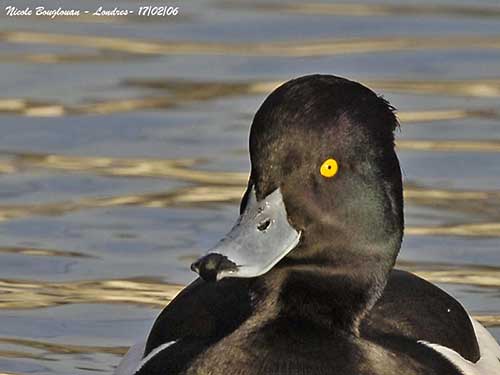
Fr: Fuligule morillon
Ang: Tufted Duck
All: Reiherente
Esp: Porrón Moñudo
Ita: Moretta
Nd: Kuifeend
Sd: Vigg
Photographers:
John Anderson
John Anderson Photo Galleries
Didier Buysse
Vision d’Oiseaux
Steve Garvie
RAINBIRDER Photo galleries & Flickr Rainbirder
Otto Plantema
Trips around the world
Nicole Bouglouan
PHOTOGRAPHIC RAMBLE
Text by Nicole Bouglouan
Sources:
HANDBOOK OF THE BIRDS OF THE WORLD vol 1 by Josep del Hoyo-Andrew Elliot-Jordi Sargatal - Lynx Edicions - ISBN: 8487334105
THE HANDBOOK OF BIRD IDENTIFICATION FOR EUROPE AND THE WESTERN PALEARCTIC by Mark Beaman, Steve Madge - C. Helm - ISBN: 0713639601
THE COMPLETE BOOK OF BRITISH BIRDS – Written by “Royal Society for the Protection of Birds” experts - Préface de Magnus Magnusson - Michael Cady- Rob Hume Editors - ISBN: 0749509112
GUIDE DES CANARDS, DES OIES ET DES CYGNES – de Steve Madge - Delachaux et Niestlé - ISBN: 2603013769
BIRDS OF THE MIDDLE EAST by R.F. Porter, S. Christensen, P Schiermacker-Ansen C.Helm - ISBN: 0713670169
Animal Diversity Web (University of Michigan Museum of Zoology)
Bird Web (Seattle Audubon Society)
What Bird-The ultimate Bird Guide (Mitchell Waite)
Pájaros de España (JL Beamonte)
Tufted Duck
Aythya fuligula
Anseriformes Order – Anatidae Family
INTRODUCTION:
The Tufted Duck is a medium-sized freshwater diving duck of the subfamily Anatinae, tribe Aythyini. The ducks of genus Aythya are fairly similar to each other at least in appearance. However, they show several differences to be considered separate species.
This species included in the subfamily Anatinae shows a high degree of sexual dimorphism. The Tufted Duck male has black-and-white plumage, whereas the female is brown overall.
They breed across the North Palearctic and winter in more southern areas. They are currently considered not globally threatened, in spite of the usual threats such as pollution, drainage, agriculture expansion and human disturbance.

DESCRIPTION OF THE BIRD:
Biometrics:
Length: 40-47 cm
Wingspan: 65-72 cm
Weight: M: 600-1000 g – F: 560-930 g
The Tufted Duck has fairly rounded head with mostly steep forehead and long black crest on nape.
The adult male in summer has black head, breast and upperparts, and white flanks and underparts. On the upperwing, the flight-feathers are white with black tips. The underwing is greyish-white. Vent and undertail-coverts are black.
The black, rounded head shows purplish and green iridescence. A long black crest is conspicuous on the rear crown.
The broad bill is pale blue with black tip. The eyes are yellow. Legs and webbed feet are black.
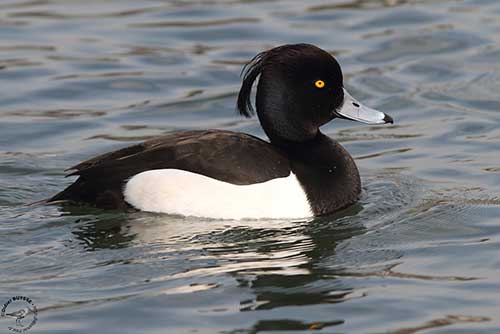
The male in eclipse plumage shows signs of vestigial tuft but usually shorter. Flanks and underparts are pale brown to buffy-white, and even resembling female, it has darker head upperparts and breast.
The adult female is dark brown with paler flanks and white area on central belly. She may have some whitish around the base of the bill and on the chin. Vent and undertail-coverts are sometimes white, especially in autumn. She has shorter crest.
The juvenile resembles female but it has lighter brown head and upperparts, usually with buff-edged feathers. The bill is darker and greyer with black nail. The eyes are brown, becoming yellow through the first winter. The young female has very dull eyes. The crest is absent in both sexes.
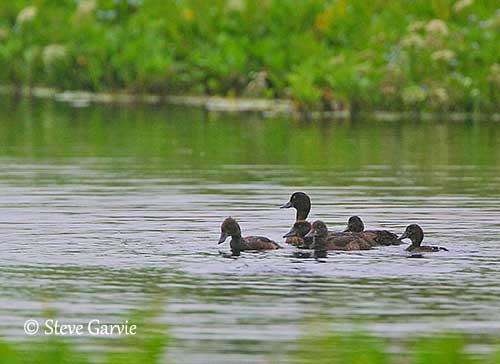
RANGE:
The Tufted Duck breeds across the northern Palearctic, from Iceland, E to Kamchatka, S to C Europe, Mongolia and occasionally N Japan (Hokkaido).
It winters in more temperate areas in C and S Europe, Africa, Middle-East and S and E Asia.
HABITAT:
The Tufted Duck breeds around lowland large freshwater lakes, ponds and reservoirs with emergent vegetation. It favours open waters and islands, and can breed sometimes along slow rivers. It breeds usually in lowland habitats, but this species has been observed nesting up to 2400 metres of elevation in the Alps.
Outside the breeding season, it frequents coastal lagoons, estuaries and tidal bays or freshwater wetlands. It can be seen in harbours, but it avoids the seacoasts with strong wave movement. It has been recorded up to 3000 metres in Kenya.
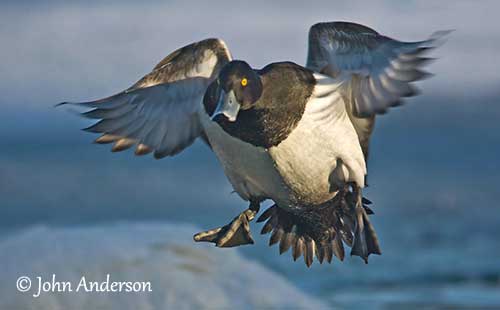
CALLS AND SONGS: SOUNDS BY XENO-CANTO
The Tufted Duck is usually silent except during the courtship displays. The male utters a low, vibrant “wheep-wee-whew” whereas the female produces a low gruff, growling “err, err, err”. During the courtship displays, she gives some “quack” or “karr” notes, and a guttural “bre bre bre” while flying.
BEHAVIOUR IN THE WILD:
The Tufted Duck feeds primarily on plant matter such as roots, seeds and buds of aquatic plants. However, it also consumes molluscs that are a major item in its diet, found both inland and in coastal waters, crustaceans, crayfish, snails and aquatic insects. It may take sometimes small fish and amphibians.
The diet varies depending on the range and the season, local conditions and food availability.
It feeds mainly by diving to reach the roots of the aquatic plants. It also skims flies and duckweed floating at the surface, while flying low over water. The dives lasts 15-20 seconds to a depth of 2,50 metres, sometimes more.
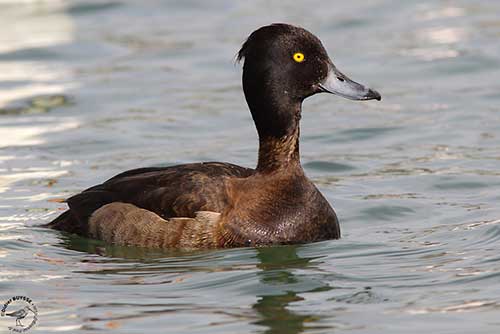
The pair forms during late winter and spring migration. Some courtship displays can be observed with both male and female swimming together while dipping their bills in and out of the water. Another display shows the males swimming quickly past female, stretching their neck out to its entire length and holding it for a few seconds. The male also swims fast while nodding the head back and forth or preening behind the wing. Copulation occurs in the water. They are monogamous for the season.
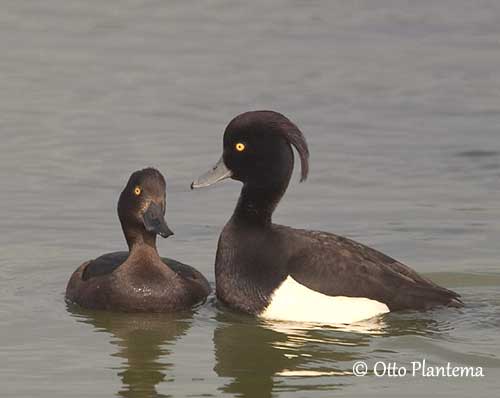
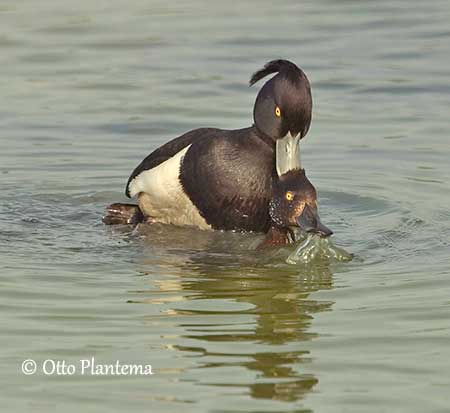
The Tufted Duck forms large flocks all year round, much larger during winter. They can be seen resting on the water or close to the shore. They become territorial during the breeding season, and the territory established around the nest is defended against neighbours and predators.
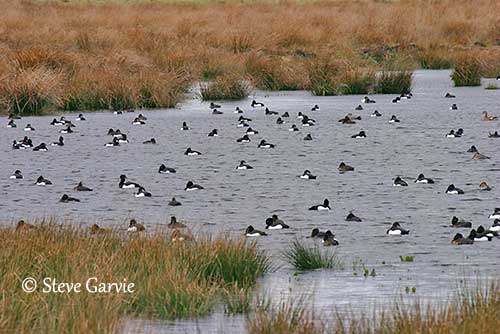
The Tufted Duck is migratory and migrates usually by night. The autumn migration starts in September and the breeding grounds are vacated by late October/November. The return migration starts in late February until late April/mid-May.
This species is an Old World duck, but it may wander to North America, reaching the NE from Europe and Iceland, and reaching Alaska and the Pacific Coast from Asia.
The Tufted Duck has fast flight, but it needs to run over the water in order to take off. The flight is direct with steady wingbeats.
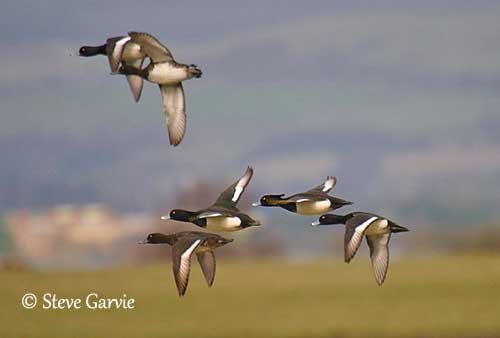
REPRODUCTION OF THIS SPECIES:
The breeding season starts in May. The Tufted Duck nests in single pairs or loose groups, usually with nests 7-11 metres apart. They nest near water, about 20 metres from the water, often among dense vegetation. When nesting on islands, the nest is sometimes up to 150 metres from the water. They may nest sometimes within gull colonies, with nests much closer to each other.
The female builds the nest on the ground, making a support with grasses and feathers, before to build the bowl-shaped structure with grass and sedges. She adds a lining of down and vegetation.
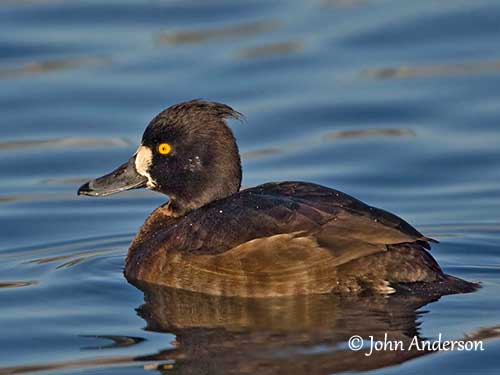
The female lays 8-10 olive-grey eggs and incubates alone during 26-28 days. During the incubation, the males form moulting flocks.
At hatching, the chicks have sooty-brown down above and pale yellowish down below. They fledge about 45-50 days after hatching. The female rears the chicks and leaves them after 30-40 days.
The Tufted Duck produces a single brood per season.
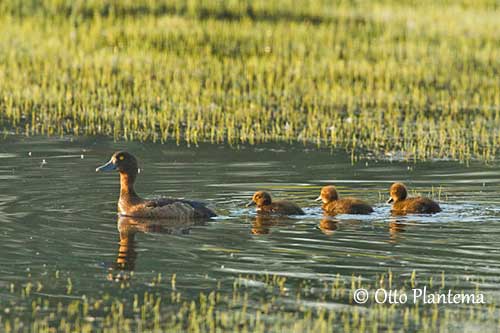
PROTECTION / THREATS / STATUS:
The Tufted Duck is threatened by degradation of the habitat through drainage, oil pollution, agriculture expansion and decrease of grazing involving scrub over-growth. Human disturbance on inland waterbodies and urban development, hunting and predation are major threats too.
The global population was estimated at 2,600,000/2,900,000 individuals in 2006. This population appears to be stable.
The Tufted Duck is currently evaluated as Least Concern.

